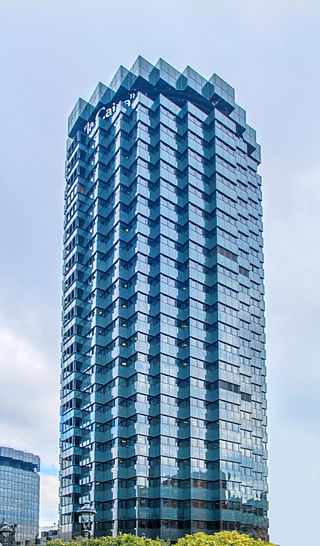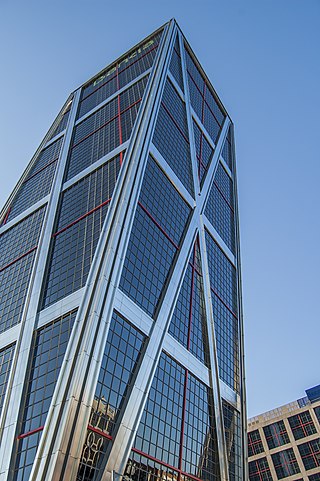Bankruptcy is a legal process through which people or other entities who cannot repay debts to creditors may seek relief from some or all of their debts. In most jurisdictions, bankruptcy is imposed by a court order, often initiated by the debtor.

GGP Inc. was an American commercial real estate company and the second-largest shopping mall operator in the United States. It was founded by brothers Martin, Matthew and Maurice Bucksbaum in Cedar Rapids, Iowa in 1954, and was headquartered in Chicago, Illinois from 2000. It was subject to the largest real estate bankruptcy in American history at the time of its filing in 2009.

Vornado Realty Trust is a real estate investment trust formed in Maryland in 1982, with its primary office in New York City. The company invests in office buildings and street retail in Manhattan.

Nueva Pescanova is a Spanish seafood company based in Redondela, Galicia. The group operates in 17 countries with approximately 12,400 employees.
Fadesa Inmobiliaria, S.A. was a Spanish real estate company.

The Spanish property bubble is the collapsed overshooting part of a long-term price increase of Spanish real estate prices. This long-term price increase has happened in various stages from 1985 up to 2008. The housing bubble can be clearly divided in three periods: 1985–1991, in which the price nearly tripled; 1992–1996, in which the price remained somewhat stable; and 1996–2008, in which prices grew astonishingly again. Coinciding with the financial crisis of 2007–08, prices began to fall. In 2013, Raj Badiani, an economist at IHS Global Insight in London, estimated that the value of residential real estate has dropped more than 30 percent since 2007 and that house prices would fall at least 50 percent from the peak by 2015. Alcidi and Gros note; “If construction were to continue at the still relatively high rate of today, the process of absorption of the bubble would take more than 30 years”.
Fortress Investment Group is an American investment management firm based in New York City. Fortress was founded as a private equity firm in 1998 by Wes Edens, Rob Kauffman, and Randal Nardone. When Fortress launched on the NYSE in February 2007, it was the first large private equity firm in the US to be traded publicly. In December 2017, Fortress was fully acquired by SoftBank Group, was delisted, and returned to being a privately held company. Fortress manages $44.7 billion of assets under management as of June 30, 2023, on behalf of over 1,900 institutional clients and private investors worldwide across a range of credit and real estate, private equity and permanent capital investment strategies. In May 2023, Mubadala Investment Co agreed to acquire a majority stake in Fortress from Softbank for an undisclosed sum.

ProMedica Senior Care, formerly HCR ManorCare Inc, is a major provider in the United States of both short-term post-acute and long-term care. As of 2020, it had more than 300 skilled nursing and rehabilitation centers, assisted living facilities hospice and home health care offices, and over 45,000 employees. The company is headquartered in Toledo, Ohio. In July 2007, it agreed to a $4.9 billion buyout offer from the private equity firm Carlyle Group. In 2018, HCR ManorCare filed for bankruptcy protection and agreed to be taken over by its landlord, Quality Care Properties and in April 2018, Quality Care Properties was acquired by a joint venture between Welltower and ProMedica. In November 2022, ProMedica announced it would end its joint venture with Welltower and would cede its 15% ownership of ProMedica Senior Care. Welltower announced a partnership with Integra Health shortly after which will take over control of all but 10 skilled nursing facilities from ProMedica. ProMedica will continue to operate the assisted living facilities gained under the original agreement.

CaixaBank, S.A., formerly Criteria CaixaCorp, is a Spanish multinational financial services company. CaixaBank is based in Valencia, with operative offices in Madrid and Barcelona, Spain. It is Spain's third-largest lender by market value, after Banco Santander and BBVA. CaixaBank has 5,397 branches to serve its 15.8 million customers, and has the most extensive branch network in the Spanish market. It is listed in the Bolsa de Madrid and is part of the IBEX 35.

The bankruptcy of Lehman Brothers on September 15, 2008, was the climax of the subprime mortgage crisis. After the financial services firm was notified of a pending credit downgrade due to its heavy position in subprime mortgages, the Federal Reserve summoned several banks to negotiate financing for its reorganization. These discussions failed, and Lehman filed a Chapter 11 petition that remains the largest bankruptcy filing in U.S. history, involving more than US$600 billion in assets.

Obrascón Huarte Lain, S.A. ; branded as OHLA Progress Enablers since July 2021, is a Spanish multinational construction and civil engineering company. The company is involved in infrastructure and commercial property construction, homebuilding and the operation of toll road and other transport concessions. In the latter, the group is particularly active in Mexico. OHLA also has a majority-owned American subsidiary called OHL USA which is based in College Point, New York.
Chrysler LLC and 24 of its affiliated subsidiaries filed a consolidated petition for bankruptcy on April 30, 2009, with the federal bankruptcy court in New York. The court filing occurred upon failure of the company to come to an agreement with its creditors for an outside-of-bankruptcy restructuring plan, by the April 30 deadline mandated by the federal government.
The 2009 General Motors Chapter 11 sale of the assets of automobile manufacturer General Motors and some of its subsidiaries was implemented through Chapter 11, Title 11, United States Code in the United States bankruptcy court for the Southern District of New York. The United States government-endorsed sale enabled the NGMCO Inc. to purchase the continuing operational assets of the old GM. Normal operations, including employee compensation, warranties, and other customer services were uninterrupted during the bankruptcy proceedings. Operations outside of the United States were not included in the court filing.
The Lightstone Group is a privately held real estate investment company which owns and operates a diversified portfolio of multifamily, office, industrial, hotel, and retail properties. Lightstone has invested directly in individual real estate assets and in real estate operating companies. The company was founded by David Lichtenstein in 1988.

Enel Americas is a conglomerate of electric energy companies operating in South America and Central America countries: Argentina, Brazil, Colombia, Peru, Costa Rica, Panama and Guatemala. Through its affiliates it generates, transmits and distributes electric power.

Bankia was a Spanish financial services company that was formed in December 2010, consolidating the operations of seven regional savings banks, and was partially nationalized by the government of Spain in May 2012 due to the near-collapse of the institution. As of 2017, Bankia was the fourth largest bank in Spain, with total assets of €179.1 billion. In 2021, the bank merged with CaixaBank to create a new entity but preserved its original name.
Sareb is the bad bank of the Spanish government. Its purpose is to manage and disinvest high-risk assets that were transferred to it from the four nationalized Spanish financial institutions. The company was formed in 2012.
Hilco Global is a multinational financial services holding company. It operates over twenty businesses in five continents and specializes in asset valuation, advisory, monetization capital, and disposition services. Headquartered in Northbrook, Illinois, it has offices throughout the world and provides services to companies, their lenders and professional services advisers across a broad spectrum of business categories including retail, commercial, industrial and financial. Hilco Global delivers services focused on maximizing the value of under-performing and excess retail, consumer products and industrial inventory, real estate, intellectual property, including consumer brands, patents, and accounts receivable. Hilco Global is also considered one of the largest distressed investment and advisory companies in the world.
Ismael Clemente, is the CEO and vice president of the Merlin Properties real estate group, of which he was also the main developer.
The expression Spanish real estate crisis or property crisis that began in 2008 refers to the set of economic indicators that, with all their severity in 2010, would evidence the deterioration of real estate expectations and of the construction industry in Spain in the context of a global economic crisis and the property bubble in Spain. Such indicators would be, mainly, the decline in units sold, the sharp fall in housing prices and the increase in the number of developers and construction companies declared bankrupt or in financial difficulties. Spain, however, is not the only country affected. The crisis has spread to other areas, leading to the Spanish crisis of 2008-2014.










